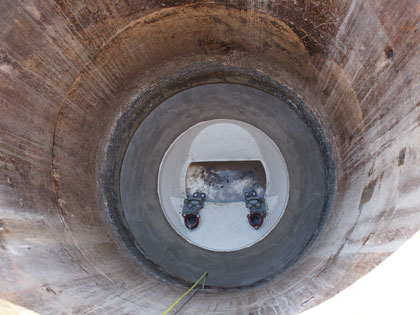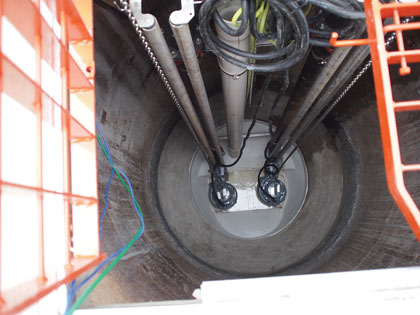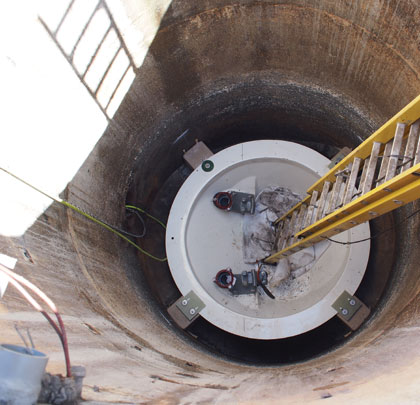Warrenton, Oregon, is located in Clatsop County on the northwestern tip of the state. A small coastal community with a population of about 5000 people, Warrenton is bordered by the Pacific Ocean on the west and the Columbia River on the north. Originally platted in 1889, the city was incorporated under the laws of Oregon in 1899.

Figure 2: TOP basin sealed in place, forms new bottom of well.
By 2012, Warrenton’s SW Alder pump station was rapidly reaching the end of its life. In fact, it had even become more cost effective to run a diesel backup pump at the station as opposed to refurbishing the existing dry mounted pumps. The station was originally equipped with 10 horsepower pumps designed to generate 400 gallons (1514.16 liters) per minute at 34-foot (10.36 meter) total dynamic head feeding into a shared force main. But the pumps had difficulty meeting this requirement and often wound up running against shut off head at the primary pump station. This situation is known as “deadheading,” which occurs when the discharge of a pump is closed. Typically, the pump goes to its maximum shut-off head and fluid is recirculated within the pump, which can result in overheating and subsequent damage.

Figure 3: Rail system permits Flygt pumps to be easily mounted in position.
During a high rain event, significant inflow and infiltration could cause the overburdened SW Alder station to operate continually for eight to ten hours, deadheading for most of that time. This was a significant issue as the potential for an overflow event made every storm front a cause of concern for maintenance staff. In addition, the long-term deadheading affected the lifespan of the existing pumps significantly. Another factor in the operation of the SW Alder plant was a large food-oil-grease component that entered the station, which at the time necessitated multiple weekly cleanings. The running costs based on power and maintenance records along with cost allocation for staff time at the site averaged $21,898 annually.

Figure 4: Flygt’s small adaptive N-pumps
The city decided to refurbish the wet well and controls in 2013. An RFP was issued requiring suppliers to meet minimum material standards and operational conditions for the pump and variable-frequency drive duplex operation. As the specification allowed for innovation above the minimum standards, the Portland branch of Xylem Water Solutions submitted Flygt’s Experior™ Pump System package of two NP3127 10 horsepower submersible pumps, which include N impellers and SmartRun controls.
The Experior Pump System combines N technology, premium efficiency motors, and intelligent controls to maximize reliability and efficient operation. The N impellers are self-cleaning, which improves their efficiency and lowers power usage. SmartRun controls provide the benefits of variable speed pumping, optimized to achieve energy savings and maximum cleaning within wastewater pumping stations.
This pump-impeller-controls combination maximized power and cleaning savings for the city. This submission was the successful low bid—$32,803 for equipment—and met all of the city’s criteria. Importantly, the city received a non-conforming bid using traditional materials of construction that was $665 lower than Flygt’s conforming offer. This gives a good baseline for the cost difference between traditional design and newer materials along with the more modern approach to controls.

Figure 5: Flygt pump control panel.
Upon review of the project with Jim Rankin of JB Rankin Engineering, the city’s engineer for this project, it was decided that a Flygt TOP 150 pre-engineered fiberglass insert should be installed in the existing pump station to control grease and solids in the wet well. The TOP 150 insert is a factory built fiberglass insert for existing concrete pump stations designed to pump wastewater or storm water in municipal sewage systems, in commercial facilities, and other applications where the removal of solids and scum is a priority.
Custom installation brackets would also be used to suspend the insert off the floor in the existing eight-foot diameter wet well to avoid having to remove the original benching. Initial engineer’s estimate for installation of standard equipment without the TOP insert was $80,000. It compared well to the chosen contractors actual bid of $79,032. This made the inclusion of the TOP 150 insert a no-cost option and provided the station with a self-cleaning bottom design.
As shown by the bid process, the difference between a traditional approach and using more modern design and materials has been negligible, impacting the cost of the station upgrade very little. However, the positive effects of a modern design using newer materials have been dramatic in terms of reliability, power savings, breakdown and emergency operation concerns, cleaning, and the necessity to stock spare parts.
City staff has been able to reduce pump station cleaning to either monthly or bi-monthly routines without the need to add degreaser, which was previously required prior to the upgrade. Power consumption has been reduced by 27.82 percent with vastly shorter run times (pumps operating near or against shut off use less power in operation over a longer running time), making damage due to operating near shut off a thing of the past. In the first year the station will have cost $6,290.00 in operating expenses, saving the city $15,607 from the original pre-rebuild operating costs.
Based on the power and maintenance history, it is estimated that a rebuild using the traditional methodology would have cost the city $14,832 to operate annually; the modern design and materials saved $8542 savings when compared to the more traditional approach. Naturally, as the station is still within the warranty period, the absence of breakdown costs associated with the old station also needs to be taken into account for comparative analysis.
To provide a suitable baseline for ongoing pump and control maintenance, the Xylem Gold TotalCare program can be utilized, which offers three TotalCare Options—gold, silver and bronze. Gold provides bi-annual service visits and 100 percent part replacement costs on parts and labor on the installed pumps. This allows the city to base its operating costs on a fixed number for the upkeep of the pumps with no additional surprises. Based on one-year-old pumps and an allowance of $500 per year to cover additional electrical components, the cost to maintain the pumps in operational condition would be $2612 with a three-year contract.
By implementing the program, the city could adjust its annual budgeted operational cost to $8,902. This would provide a realistic saving to the city’s operating budget of $12,996 per year or a total operating cost reduction of an impressive 59.35 percent.
SW Alder pump station used to be considered a moderate to high maintenance station with ageing infrastructure, reliability issues and peak loading concerns. It is now a model of what can be achieved by utilizing a modern approach to refurbishment. The city can effectively redirect almost $13,000 (compared to an estimated $4450 using traditional materials and designs) annually towards other asset management requirements as well as enjoy greater reliability in operation, which will further reduce additional overtime expenditures. In addition, with significant reduction in electrical power used, the city is able to meet the community’s current energy consumption and environmental impact expectations. ■
About the Author
Flygt, a Xylem brand, is a world leader in the design and manufacture of dry and submersible pumps, mixers and related intelligent controls systems. Under the Flygt banner, customers have access to a complete range of products and solutions for moving water, wastewater, and advanced monitoring and control equipment to optimize their use. For more information on Flygt and its parent company, visit www.xyleminc.com.
MODERN PUMPING TODAY, October 2014
Did you enjoy this article?
Subscribe to the FREE Digital Edition of Modern Pumping Today Magazine!


